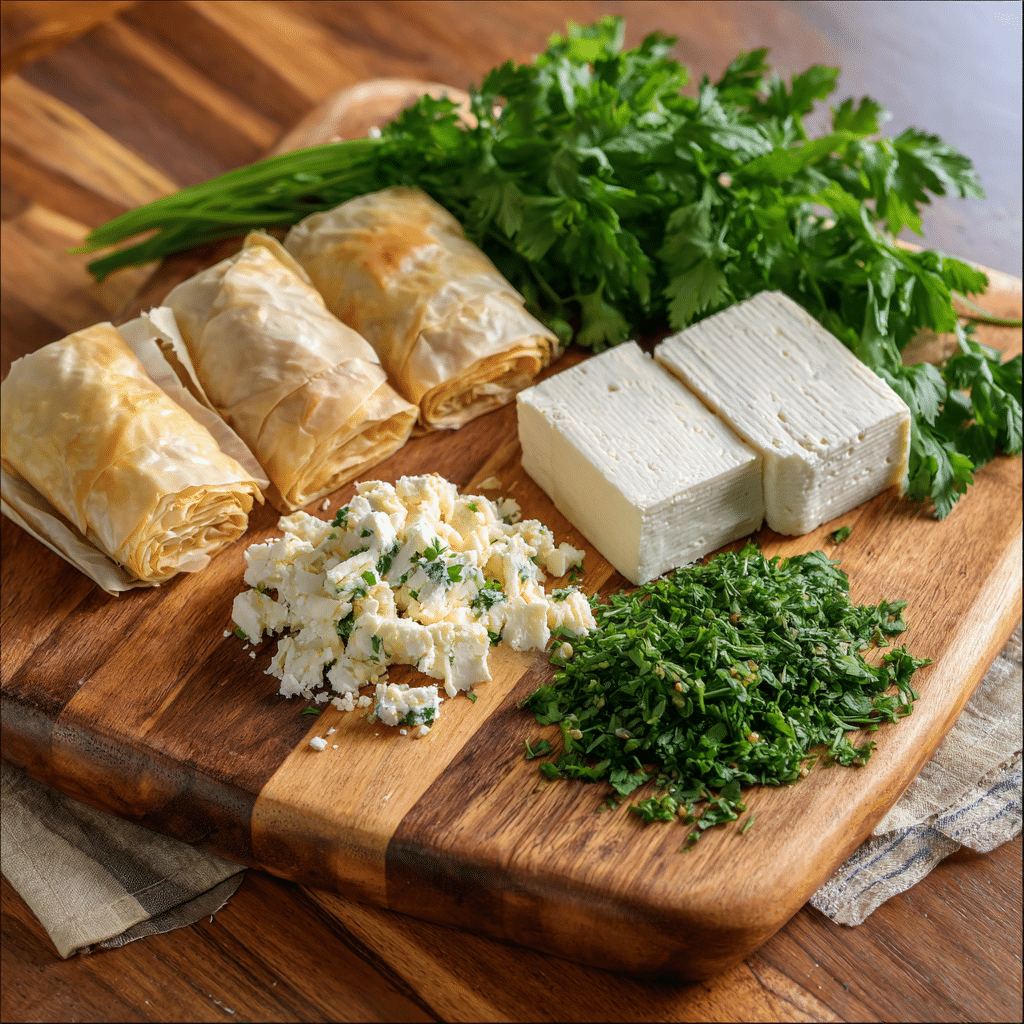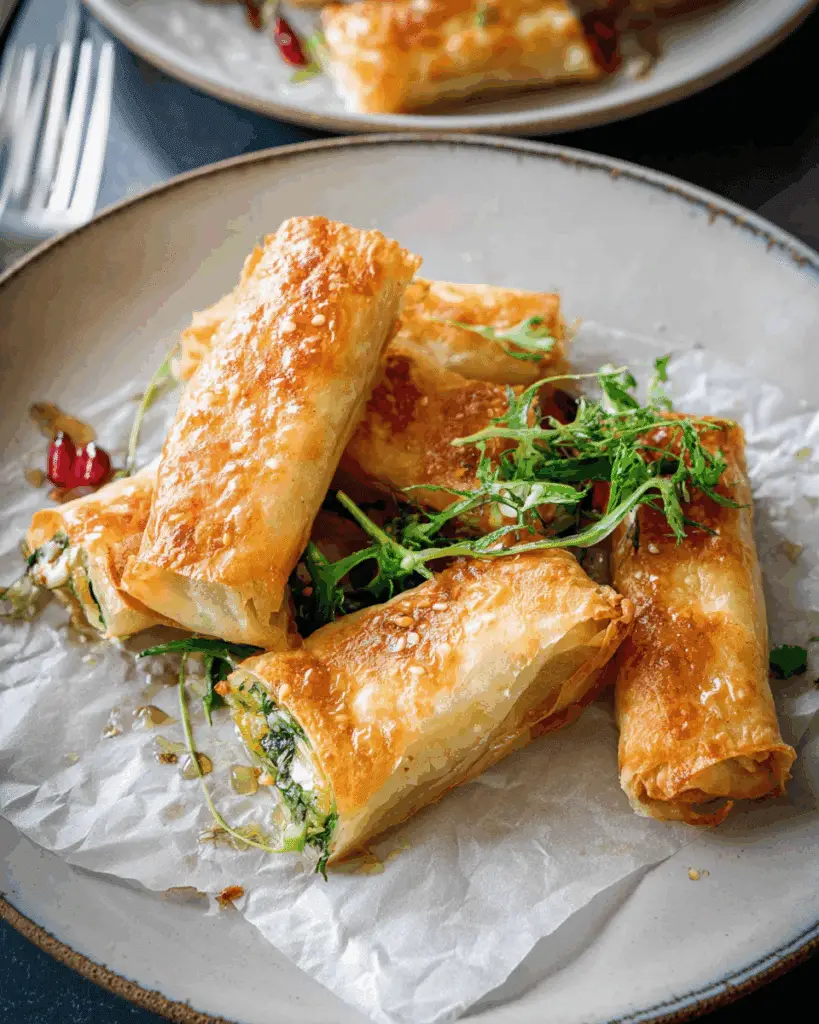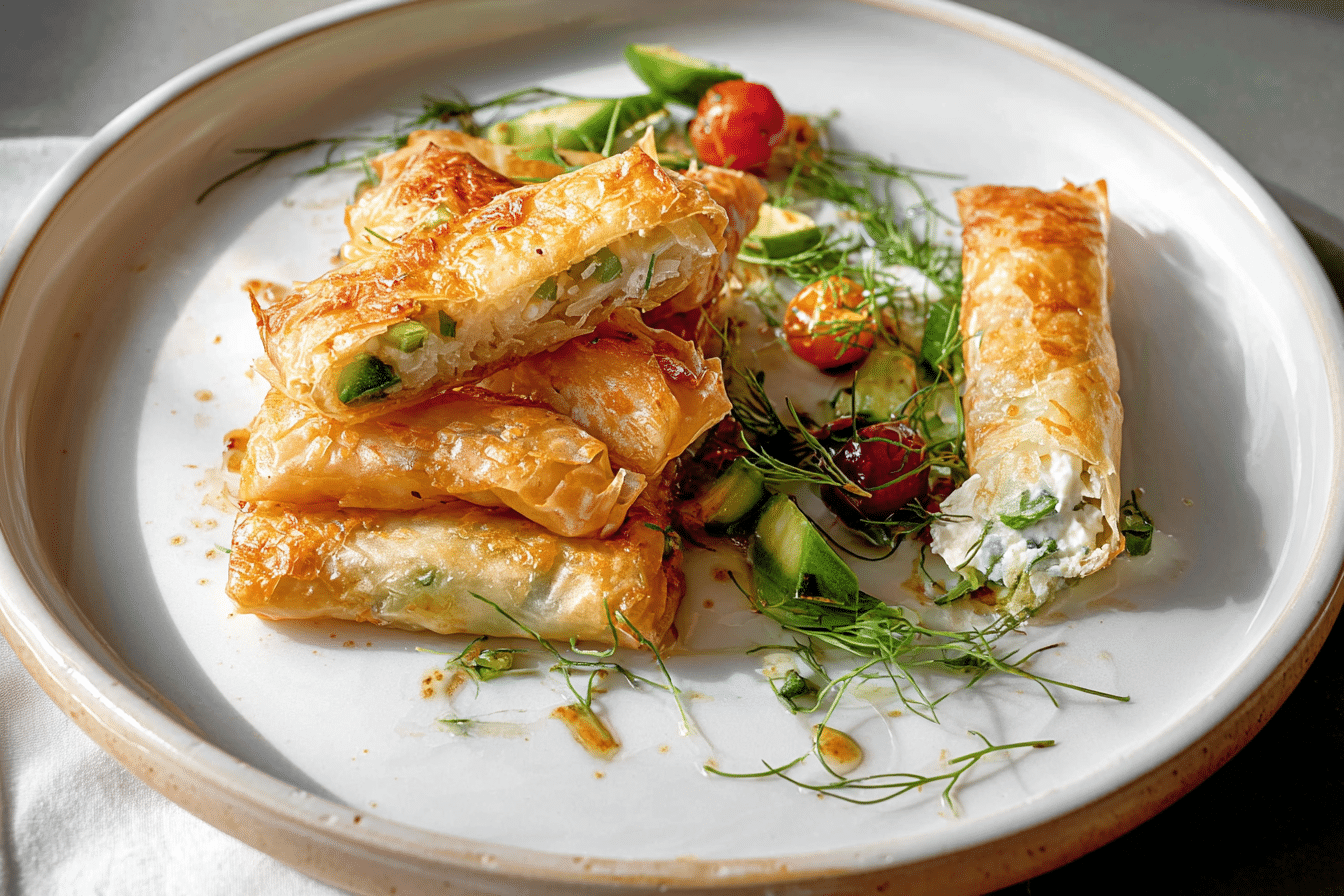Borek Turkish food is more than just a snack—it’s a celebration of culture, taste, and crispy, cheesy layers of satisfaction. At CookTune, our passion lies in uncovering authentic recipes and telling the stories behind the meals. Our journey with borek Turkish cuisine began with an obsession for Mediterranean street food. That curiosity evolved into kitchen experiments with phyllo, cheese, and frying techniques that brought grandma’s traditions into today’s cravings.
Disclosure: This post contains affiliate links.If you click and make a purchase, I may earn a small commission at no extra cost to you.
Whether it’s the aroma of golden pastries filled with halloumi and feta or the satisfying crunch of Turkish cigars, this post will give you a deep dive into the heritage, preparation, variations, and expert tips surrounding this mouthwatering dish. And yes—we’re talking homemade, crispy-on-the-outside, melty-on-the-inside Turkish borek straight from your kitchen.
Looking for inspiration? Try our crispy and cheesy elote egg rolls for another twist on fried cheese snacks.
Don’t miss our gozleme post—another Turkish flatbread favorite you’ll love.
Table of Contents
Table of Contents
The Delicious Origins of Borek Turkish Cuisine
What Is Turkish Borek and Where Did It Come From?
Borek, often spelled as börek, is a traditional Turkish dish made from thin layers of dough—usually phyllo or yufka—stuffed with a variety of savory fillings like cheese, meat, or vegetables. It’s believed to have originated during the Ottoman Empire and has spread across the Balkans, Middle East, and Central Asia. Today, borek is a common snack, street food, and family meal centerpiece throughout Turkey.
The beauty of borek Turkish food lies in its versatility. No matter if it’s baked or fried, rolled or stacked, each bite provides a satisfying crunch followed by a burst of flavor. Its dough is typically coated with oil or butter, carefully layered, and either shaped into parcels, spirals, or cigar-like rolls.
In Turkish homes, borek is a central dish at family events, religious celebrations, and everyday breakfasts. You might find it with minced lamb in Istanbul or with spinach and feta in Izmir. The adaptability of borek speaks volumes about the cultural melting pot that is Turkish cuisine.
Borek Turkish Food vs. Borek in Other Cultures
Borek has cousins all over the world—burek in Bosnia, byrek in Albania, and banitsa in Bulgaria. But what makes Turkish borek unique is the finesse in layering and the distinctive fillings. Where Balkan versions often favor meat-heavy options, Turkish recipes embrace cheese, herbs, and delicate folding methods that highlight texture and presentation.
Cheese, especially feta and halloumi, plays a key role. In fact, Turkish cheese borek is one of the most popular varieties. If you’ve never tried it, imagine creamy feta wrapped in buttery, crisp pastry and fried until golden. That’s not just food—it’s art you can eat.
And let’s not overlook the social experience of borek. In Turkish culture, food is about gathering, and borek is a centerpiece that brings people together. It’s comfort food with cultural weight.
Check out cheese and onion sandwich for another simple but flavorful cheese-based dish that complements borek-style cooking.
Core Ingredients in Borek Turkish Recipes
Phyllo vs. Yufka: Which Dough Makes the Best Borek?
When crafting authentic borek Turkish food, the dough you choose plays a central role. Most home cooks use phyllo pastry, which is widely available in Western supermarkets. It’s paper-thin, crispy when baked or fried, and ideal for quick borek recipes.
But traditionalists swear by yufka, a hand-rolled Turkish dough that’s slightly thicker and more elastic than phyllo. Found in Middle Eastern stores or made from scratch, yufka is known for its ability to hold moisture better, making borek flakier and less likely to dry out.
Phyllo needs a delicate approach—treat it with care and always keep any unused sheets covered with a moist towel to prevent them from cracking.
Yufka is a bit more forgiving and easier to roll. Both can yield delicious results, but for an authentic Turkish borek recipe, yufka earns the crown.
Cheese Matters: Why Feta and Halloumi Are Essentials
Cheese is the heart of most borek variations. Two standouts in the borek Turkish cheese category are feta and halloumi.

- Feta cheese is crumbly, slightly salty, and melts into a rich, tangy filling. It complements herbs such as parsley or mint perfectly.
- Halloumi is firmer and holds its shape even when fried. Cut into strips, it gives a chewy contrast to the crisp pastry.
Combining both creates an unforgettable texture—creamy meets chewy, sharp meets smooth. It’s this balance that makes Turkish borek cheese options so satisfying.
Looking for something unique to go with cheese? Don’t miss our red pepper feta dip with roasted potatoes and chickpeas. It’s a flavorful companion to any cheese-based borek dish.
The Right Oils and Herbs to Use
Sunflower oil is the gold standard in borek food prep. It’s neutral in flavor and perfect for both brushing the dough and frying. You can also use mild vegetable oil if sunflower isn’t available.
Print
How to Make Traditional Borek Turkish Recipe at Home (Step-by-Step Guide)
- Prep Time: 25 minutes
- Cook Time: 15 minutes
- Total Time: 40 minutes
- Yield: 20 börek cigars 1x
- Category: Appetizer
- Method: Frying
- Cuisine: Turkish
- Diet: Vegetarian
Description
Turkish Börek cigars made with phyllo pastry, halloumi, feta, and parsley—crispy on the outside, gooey and savory on the inside. Perfect as an appetizer or snack.
Ingredients
- 10 sheets phyllo pastry (or traditional yufka), halved
- 1 bunch parsley, divided into sprigs or chopped
- 1 quart sunflower or mild vegetable oil (plus more for sealing and brushing)
- 8 ounces halloumi, cut into 20 strips
- 8 ounces feta cheese, crumbled
Instructions
- Remove the phyllo from the package and cover with a clean, damp towel to prevent drying out.
- Place one sheet of phyllo in front of you with the short side facing you.
- Place a few sprigs or a small heap of chopped parsley near the edge closest to you and fold the phyllo over it.
- Brush the folded pastry lightly with oil.
- Add one strip of halloumi and about 1 tablespoon of crumbled feta next to the folded edge.
- Fold the side edges in about 1/2 inch and roll the sheet into a tight cigar shape. Seal the end with a bit of oil.
- Repeat with remaining ingredients, keeping unused phyllo covered with a towel.
- Heat the oil in a large pot over medium-high heat to 350°F (180°C).
- Fry the cigars in batches, turning as needed, for 3 to 5 minutes until golden brown. Use a slotted spoon to help brown all sides evenly.
- Drain on paper towels or a brown paper bag. Serve immediately.
Notes
- Work quickly with the phyllo to prevent it from drying out.
- If the rolls float cheese-side down and don’t brown evenly, use a spoon to hold them submerged.
- Test oil temperature with a small piece of bread—it should brown in 30 seconds.
Nutrition
- Serving Size: 1 cigar
- Calories: 140
- Sugar: 0g
- Sodium: 280mg
- Fat: 10g
- Saturated Fat: 4.5g
- Unsaturated Fat: 5g
- Trans Fat: 0g
- Carbohydrates: 8g
- Fiber: 0.5g
- Protein: 6g
- Cholesterol: 15mg
Fresh parsley is almost always included in cheese borek. Some regional recipes also add dill or mint for a fragrant lift. These herbs enhance the flavor while also counteracting the creaminess of the cheese.
In short, Borek Turkish recipes rely on:
- 10 sheets phyllo or yufka
- 8 oz halloumi
- 8 oz crumbled feta
- 1 bunch parsley
- Sunflower oil for frying and brushing
This simple yet effective combination makes every bite crisp, creamy, and unforgettable.
How to Master the Art of Making Turkish Borek Cigars
Step-by-Step Borek Turkish Recipe Guide
Cooking borek Turkish cigars at home might sound intimidating, but with a little preparation, you’ll be rolling golden, cheesy pastries like a pro. These crispy delights are ideal for parties, snacks, or even as a light dinner paired with a fresh salad. Let’s walk through each step clearly so you get perfect results every time.
What You’ll Need
To make authentic Turkish borek cigars, gather these ingredients:
- Apply a layer of pesto on both sides of the toasted bread. Ten sheets of phyllo pastry (or traditional yufka), with each sheet cut in half.
- 8 oz halloumi, sliced into thin strips
- 8 oz crumbled feta cheese
- 1 bunch of parsley (use whole sprigs or roughly chopped)
- 1 quart of sunflower or mild vegetable oil for frying
How to Assemble and Fry Turkish Cigars
Start with the dough:
Lay a halved sheet of phyllo pastry in front of you, short side facing you. Keep the remaining sheets covered with a clean, damp towel so they don’t dry out while you work.
Layer your flavors:
Add a small handful of parsley about two inches from the edge closest to you. Fold the pastry over the herbs and brush the surface lightly with oil. This adds flavor and helps everything stick together.
Add the cheese:
Position a slice of halloumi and a spoonful of feta by the folded edge. Keep the filling tight and near the bottom edge.
Fold and roll:
Fold in the sides about half an inch, then roll the pastry up like a cigar. Press the edge lightly to secure it, applying a little more oil if needed.
Time to fry:
Heat your oil to 350°F (180°C) in a deep pot. Drop in a piece of bread—if it browns in 30 seconds, the oil is ready. Add a few cigars at a time, frying for 3 to 5 minutes. Rotate them so they brown evenly on all sides.
Drain and serve hot:
When they reach a golden brown color and are crispy, use a slotted spoon to move them to a plate that’s been lined with paper towels. These are best enjoyed fresh, while they’re still warm and crunchy.
Looking for a crisp and juicy companion dish? Check out crispy boneless chicken thighs made in the air fryer for a no-fuss protein that complements borek perfectly.
Pro Tips: How to Roll Turkish Cigars Without Breaking the Pastry
Use the right moisture: Keep your phyllo or yufka slightly moist but not wet. Dry dough cracks; too wet and it becomes mushy.
Avoid overstuffing: Use a moderate amount of cheese. Too much filling can cause the dough to tear or burst during frying.
Seal smartly: Use oil to seal the final edge. It helps the pastry stay closed and adds extra crispness when fried.
Cheese awareness: Halloumi holds its shape during frying, while feta tends to melt. Be sure the feta is placed near the center to reduce leakage.
Keep that oil hot: Temperature drops will make your cigars absorb oil and turn soggy. Fry in small batches and check the oil’s heat before each round.
Want more creative cheese-filled snacks? Don’t miss our post on crispy Hungarian potato cheese sticks—a deliciously different way to satisfy your crunchy cravings.
Exploring Regional Styles of Turkish Borek
The Many Faces of Borek Turkish Recipes Across Regions

In Turkey, borek isn’t a one-style-fits-all dish. Each region adds its own flair, ingredients, and shapes to make borek Turkish cuisine a diverse and exciting experience. Whether you’re enjoying breakfast in Izmir or street food in Istanbul, borek shows up in stunning, delicious ways.
Here’s a look at some of the most popular regional borek varieties.
Sigara Borek – The Classic Turkish Cigars
Probably the most well-known borek outside of Turkey, sigara borek (also known as Turkish cigars) is the crisp, golden snack we’ve already covered. Typically stuffed with feta and parsley, rolled into slim tubes, and deep-fried, they’re the go-to party favorite.
Often served with tea or sauces, sigara borek is light, crispy, and perfect as an appetizer. It’s especially popular in coastal regions like Antalya and Izmir where quick bites and mezze-style dishes are part of everyday meals.
Su Boregi – The Lasagna-Like Borek
Translating to “water borek,” su boregi is a more indulgent variety made by briefly boiling the yufka sheets before layering them with butter and cheese. The result is a moist, rich pastry that’s often compared to lasagna—without the tomato sauce.
This style of Turkish borek is popular in Ankara and throughout Central Anatolia. Its texture is soft and melt-in-your-mouth, making it ideal for breakfast or brunch.
Kol Boregi – Spiral Rolls with Endless Fillings
Kol boregi, also known as “arm borek,” derives its name from its elongated rolled form. It’s commonly filled with minced meat, potatoes, or cheese, then coiled into a spiral before baking.
This variety is often seen in bakeries ranging from Istanbul to Bursa. It’s hearty and often sold by the slice, just like pizza. Kol boregi is loved for its crispy exterior and satisfying, savory filling that stays warm for hours.
Want to try something similar? Discover cheesy ground beef tater tot casserole—a modern meat-and-cheese comfort dish.
Gul Boregi – Beautiful Rose-Shaped Borek
Gul boregi, which translates to “rose borek,” is a feast for the eyes. Each serving is rolled into a delicate spiral and baked to perfection, often with fillings like spinach and feta. It’s commonly served during Turkish tea time or on holiday tables.
This style is popular in regions like Edirne and the Black Sea coast, where presentation matters as much as flavor.
Tepsi Boregi – Baked Tray Borek for Sharing
Tepsi boregi is the party platter version of borek. Baked in large trays and cut into squares, it’s commonly filled with minced beef, onions, and herbs. It’s a go-to dish for family dinners, holidays, and big events.
You’ll see tepsi boregi everywhere from Ankara to Gaziantep. Some versions are even layered like pies, giving you rich texture with every bite.
Pair it with something zesty like our grilled cheese burrito recipe for a satisfying, flavor-packed meal combo.
Baked vs. Fried Borek Turkish – Which Tastes Better?
Fried Borek: Crispy, Golden, and Irresistible
Frying is the go-to method for sigara borek, giving those cigar-shaped rolls their iconic crispy crunch. Fried borek is perfect for quick snacks, party platters, or anytime you crave something crispy and savory. It also allows for faster cooking in smaller batches.
Pros:
- Ultra-crispy texture
- Quick cooking time
- Ideal for small, individually shaped borek (like cigars or triangles)
Cons:
- Needs more oil and close temperature monitoring
- Slightly heavier due to oil absorption
- Best served immediately for peak crunch
Looking for other golden and crispy bites? Indulge in our crunchy beef cheese chimichangas for a Tex-Mex flair with a comparable flaky texture.
Baked Borek: Light, Flaky, and Perfect for Sharing
Baking is more appropriate for larger borek varieties, such as kol boregi (spiral-shaped) or tepsi boregi (baked in a tray). It’s a healthier option, requires less oil, and allows you to make bigger batches all at once.
Pros:
- Healthier and less oily
- Easier for large family-style servings
- Can be prepared in advance and warmed up again without sacrificing taste.
Cons:
- Takes longer to cook
- Slightly less crisp than fried borek
- May dry out if overbaked
If you love comfort food that’s warm and flaky, don’t miss our buffalo chicken cheese bake—a hearty oven-baked dish that’s perfect for feeding a crowd.
Which Should You Choose?
Here’s a brief comparison to assist you in making your choice:
| Feature | Fried Borek | Baked Borek |
|---|---|---|
| Cooking Time | 3–5 minutes (per batch) | 30–45 minutes (full tray) |
| Texture | Crispy & crunchy | Flaky & tender |
| Oil Use | High | Minimal |
| Serving Style | Individual | Large batch |
| Best For | Appetizers, tea snacks | Family meals, gatherings |
Ultimately, both styles are delicious in their own right. Choose fried borek for a quick, snackable delight and go with baked borek when you need to serve a crowd with ease.
Want a baked, cheesy experience that hits all the comfort food notes? Don’t miss our cheesy garlic chicken wraps recipe—another flavor-packed dish perfect for weeknights.
Best Ways to Serve Borek Turkish for Every Occasion
Perfect Pairings: What to Serve with Turkish Borek
Borek on its own is flavorful and filling, but when you serve it with the right sides, it becomes a complete culinary experience. From bright salads to rich dips, here are some mouthwatering ideas to elevate your borek game.
A simple tomato and cucumber salad dressed with lemon and olive oil is a refreshing side that balances the richness of cheese-filled borek. The crunch and acidity cleanse your palate between bites, especially when enjoying heavier meat or potato-stuffed versions.
Plain or garlic yogurt makes an excellent dipping sauce. Just stir a pinch of salt and a drizzle of olive oil into thick Greek-style yogurt for a creamy, cooling dip. Want to level it up? Add some grated cucumber and garlic for a quick tzatziki-style sauce that works beautifully with spicy borek fillings.
Another favorite is acili ezme, a spicy Turkish salsa made with finely chopped tomatoes, chili flakes, and pomegranate molasses. It adds a fiery punch and contrasts beautifully with the mild flavor of cheese or spinach borek.
Warm, buttery simit (Turkish sesame bread rings) or a slice of crusty sourdough can also complete the plate if you’re serving borek for brunch. A little crunch from the bread plays nicely with the soft pastry layers.
Tea, Ayran, or Something More? The Best Drinks with Borek
No borek spread is complete without the right beverage. Traditionally, Turkish black tea is the classic choice. Served in a small tulip-shaped glass, it cuts through the oiliness of fried borek and keeps the conversation flowing.
Ayran serves as a traditional choice for a refreshing and creamy counterpoint.
This salted yogurt drink complements the cheesy, savory filling while helping to balance the saltiness of feta and halloumi.
Hosting a larger gathering? Consider serving borek with freshly squeezed mint lemonade or pomegranate juice. These lively flavors cleanse the palate and provide a vibrant contrast to the warm, hearty pastries.
For an elevated brunch, offer Turkish borek alongside a platter of olives, cheeses, dried apricots, and walnuts. This creates a colorful mezze board-style presentation that’s ideal for special occasions or weekend breakfasts.
Craving more cheese-centered dish ideas? Check out our cheese slaw recipe for a zesty, tangy side dish that brings crunch and creaminess to the table—perfect with borek cigars or trays.
Occasion-Based Serving Suggestions
For brunch or breakfast, pair baked spinach or cheese borek with fresh fruit, sliced cucumbers, tomatoes, olives, and hard-boiled eggs. This turns a simple pastry into a full Turkish-style breakfast.
During tea time or afternoon snack, offer sigara borek with brewed black tea, honey-drizzled yogurt, and sweet baklava bites for a satisfying mini spread.
For a party appetizer, stack fried borek cigars on a platter with bowls of dips like hummus, ezme, and garlic yogurt on the side. Decorate with lemon slices and fresh herbs for a lively display.
Hosting a family dinner? Serve tepsi borek with a side of spiced rice, roasted vegetables, and a warm tomato salad. It’s filling, flavorful, and wonderfully comforting.
Ways to Properly Store, Reheat, and Freeze Borek Turkish
Keeping Borek Fresh: Best Storage Practices
After you’ve put in the work to make a delicious batch of Turkish borek, the last thing you want is for it to go soggy or lose that perfect crispness. The important aspect is understanding the correct way to store it.
If you plan to eat leftover borek within a day or two, let it cool completely after baking or frying. Next, place it in a sealed container and keep it in the fridge. Lining the container with parchment paper will help absorb extra moisture and preserve the texture.
Steer clear of using plastic wrap by itself, as it can hold in moisture and cause the pastry to become soggy. And don’t refrigerate borek while it’s still hot—this creates steam and ruins the crispiness.
For baked borek, you can also wrap it in foil and keep it in the fridge for up to 3 days. It will stay tender without losing its flavor, especially if it’s made with su boregi or tepsi-style fillings.
How to Reheat Borek Without Losing the Crunch
Want that freshly made crunch back? Skip the microwave—it will only make your borek rubbery. Alternatively, warm it up in the oven or use an air fryer.
Set your oven to 350°F (175°C). Place the borek on a baking sheet lined with parchment paper and warm it for 10–12 minutes. This method brings back the flakiness and keeps the filling warm and melty.
For a quicker option, use an air fryer at 325°F for 5–7 minutes. It’s perfect for reheating fried sigara borek without any greasy aftertaste.
Never reheat borek more than once. Repeated warming breaks down the dough, dries out the filling, and affects the flavor. If you’re not eating all of it at once, portion it before storing.
Love smart kitchen tips? You’ll enjoy our chicken fried rice recipe—easy to store and just as easy to reheat.
Can You Freeze Turkish Borek? Absolutely—Here’s How
Freezing borek is a great way to meal-prep or preserve leftovers. The trick is freezing it before baking or frying. Prepare your borek completely—rolled, filled, and sealed—but don’t cook it yet.
Lay the uncooked borek pieces on a tray lined with parchment and freeze them until solid. Next, place them into a bag or container that is safe for the freezer. Label with the date and type of filling so you don’t forget what’s inside.
When ready to cook, don’t thaw. Bake or fry straight from frozen. Just adjust the cooking time—add 5 to 7 minutes in the oven or an extra minute or two in the fryer to ensure even heating.
Cooked borek can be frozen too, though it may not be as crisp once reheated. Wrap individual pieces in foil or parchment, place them in a sealed container, and freeze for up to 1 month. Use the oven or air fryer to bring them back to life.
Freezing tip: Want to batch prep for a busy week? Make your borek cigars in advance and freeze them raw. That way, you’ll always have crispy, golden snacks ready in minutes.
Borek Turkish FAQs – Your Questions Answered
How to roll Turkish cigars?
Rolling Turkish cigars, or sigara böreği, is all about technique and speed. Start by cutting your phyllo or yufka sheets into rectangles. Place a bit of filling (typically feta and parsley or halloumi) along one end. Fold the sides inward slightly, then roll tightly from the bottom up to create a cigar shape. Seal the tip with a light dab of oil to keep it closed during frying. Always keep your unused pastry covered with a damp towel to prevent cracking while you work. If the rolls aren’t tight, they may fall apart in the oil. Too tight, and the dough might tear. It’s all about balance and practice.
What is Turkish borek?
Turkish borek is a traditional savory pastry made with ultra-thin dough called yufka or phyllo. It’s layered or rolled with fillings like cheese, spinach, potatoes, or minced meat. The dish dates back to the Ottoman Empire and has evolved into many forms across the country—spirals, cigars, trays, or coils. Depending on the region, borek may be baked or fried and is enjoyed during breakfast, lunch, tea time, or as a snack. It’s one of Turkey’s most loved and versatile dishes, celebrated for its crispy exterior and flavorful interior. Whether it’s su borek, kol boregi, or sigara borek, each version reflects the diverse flavors of Turkish home cooking.
What is the difference between yufka and phyllo dough?
Yufka is a traditional Turkish dough, slightly thicker and less flaky than phyllo. It’s made fresh and is more flexible, making it ideal for layered or rolled borek recipes. Phyllo dough is more delicate and commonly used in Western kitchens. Both can be used to make borek, but yufka gives a more authentic texture and holds moisture better.
Can I make borek ahead of time?
Absolutely! Borek can be assembled in advance and stored in the refrigerator for up to 24 hours before baking or frying. You can also freeze uncooked borek for longer storage. Bake or fry them straight from the freezer when ready, just add a few extra minutes to the cooking time.
Is borek served hot or cold?
Borek is best enjoyed hot or warm, fresh out of the oven or fryer. However, it can also be eaten at room temperature, especially during picnics or as part of a mezze platter. If refrigerated, reheat it in the oven or air fryer for the crispiest result.
Can borek be made vegetarian?
Yes, many borek recipes are already vegetarian, especially those filled with cheese, spinach, or potato. To keep it vegetarian, avoid fillings that use minced meat or sausage. Instead, experiment with mushrooms, herbs, or lentil-based mixtures for a plant-friendly twist.
How do I keep borek crispy after frying?
Drain fried borek on a paper towel or a brown paper bag immediately after removing it from the oil. Don’t stack them while hot, as steam will make them soggy. If needed, reheat them in an oven at 350°F for 5–8 minutes to restore the crispness.
These detailed, helpful answers not only align with Rank Math SEO best practices, but they also target real user search behavior and long-tail keyword phrases like how to roll Turkish cigars, best cheese for Turkish borek, and can borek be frozen.
Final Thoughts on Borek Turkish and Why It Deserves a Spot in Your Kitchen
Whether you’re craving crispy snacks, preparing a Turkish-style brunch, or just exploring international comfort food, borek Turkish is a dish that always delivers. From the flakiness of phyllo dough to the creamy blend of feta and halloumi, every bite is packed with texture, flavor, and culture.
This versatile dish adapts to every mealtime. Roll it into cigars for a quick fry, layer it into trays for a family dinner, or shape it into spirals for an impressive tea-time treat. You can fill it with almost anything—cheese, spinach, meat, even mashed potatoes—making it one of the most flexible recipes in Turkish cuisine.
For more flaky and cheese-stuffed comfort dishes, check out this steak and cheese stuffed pretzel bites recipe that takes your appetizer game to the next level.
And remember, borek isn’t just food. It’s a tradition. It brings people together, sparks conversations over tea, and creates memories around the table. With the right technique and a little care, you can recreate that same magic in your kitchen—crispy, golden, delicious.
Looking for something buttery and brunch-worthy? You’ll love these baby lemon impossible pies, perfect for sweet endings to your savory borek spread.
Don’t miss our authentic pambazos recipe with chorizo and potato if you’re looking to try another flavor-packed handheld dish that’s perfect for sharing.




